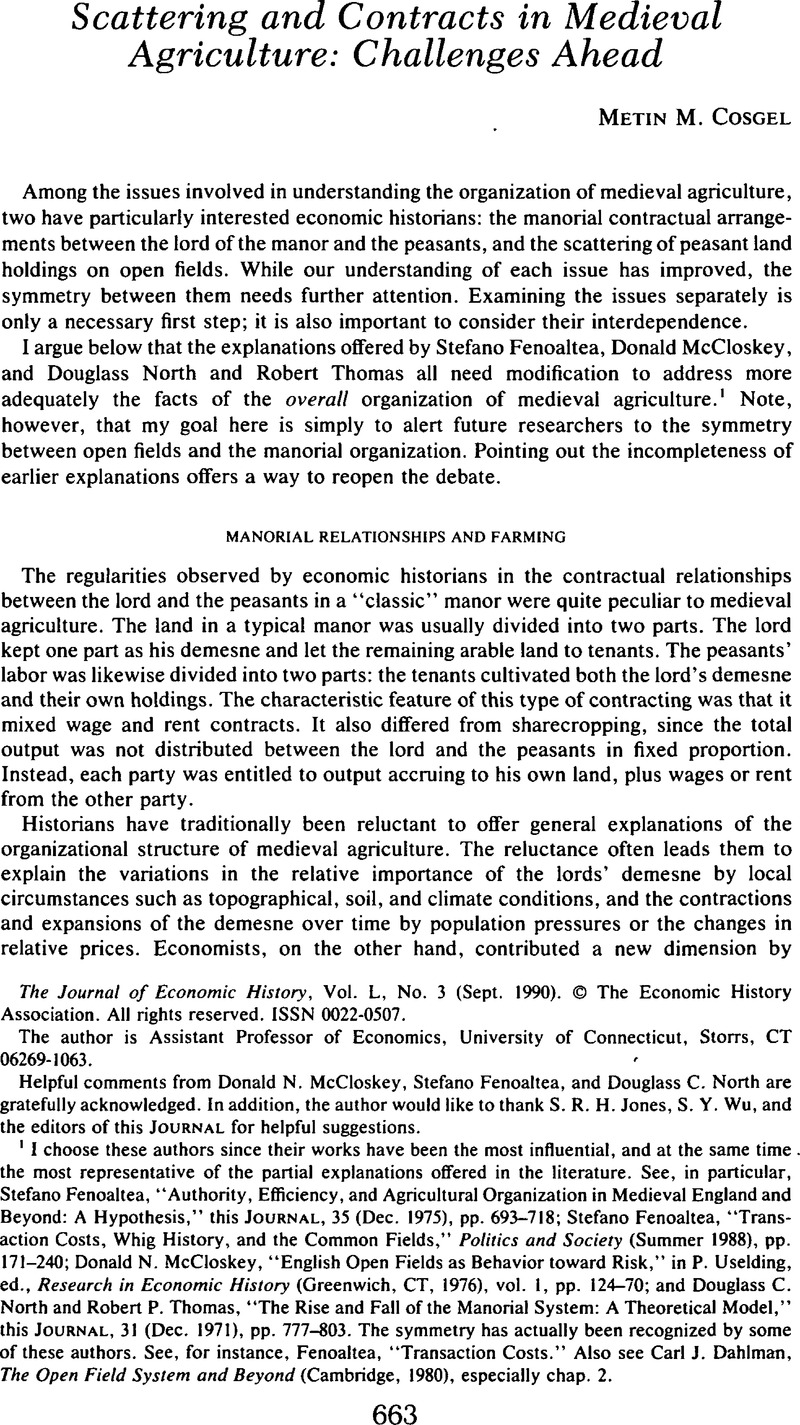Article contents
Scattering and Contracts in Medieval Agriculture: Challenges Ahead
Published online by Cambridge University Press: 03 March 2009
Abstract

- Type
- Notes and Discussion
- Information
- Copyright
- Copyright © The Economic History Association 1990
References
1 I choose these authors since their works have been the most influential, and at the same time the most representative of the partial explanations offered in the literature. See, in particular, Fenoaltea, Stefano, “Authority, Efficiency, and Agricultural Organization in Medieval England and Beyond: A Hypothesis,” this JOURNAL, 35 (12 1975), pp.;Google ScholarStefano Fenoaltea, “Transaction Costs, Whig History, and the Common Fields,” Politics and Society (Summer 1988), pp.171–240Google Scholar; McCloskey, Donald N., “English Open Fields as Behavior toward Risk,” in Uselding, P., ed., Research in Economic History (Greenwich, CT, 1976), vol. 1, pp. 124–70Google Scholar; and North, Douglass C. and Thomas, Robert P., “The Rise and Fall of the Manorial System: A Theoretical Model,” this JOURNAL, 31 (12 1971), pp. 777–803.Google Scholar The symmetry has actually been recognized by some of these authors. See, for instance, Fenoaltea, “Transaction Costs.” Also see Dahlman, Carl J., The Open Field System and Beyond (Cambridge, 1980), especially chap. 2CrossRefGoogle Scholar.
2 See Jones, Andrew, “The Rise and Fall of the Manonal System: A Critical Comment,” this JOURNAL, 32 (12 1972), pp. 938–44;Google Scholar and Fenoaltea, Stefano, “The Rise and Fall of a Theoretical Model: The Manorial System,” this JOURNAL, 35 (06 1975), pp. 386–409, for criticisms of the North-Thomas model.Google Scholar North answers the criticisms and modifies his argument somewhat in his later work, Structure and Change in Economic History (New York, 1981), particularly pp. 129–31.Google Scholar
3 urthermore, he uses the symmetry to criticize McCloskey's and Dahlman's explanations of open fields. See his “Transaction Costs.”Google Scholar
4 Fenoaltea, “Authority, Efficiency,” p. 700.Google Scholar
5 Fenoaltea, “Transaction Costs,” pp. 190–91.Google Scholar
6 Fenoaltea, “Authority, Efficiency,” p. 703.Google Scholar
7 Fenoaltea, Stefano, “Risk, Transaction Costs, and the Organization of Medieval Agriculture,” Explorations in Economic History, 13 (04 1976), p. 132.CrossRefGoogle Scholar
8 What follows is a brief description of work currently in progress. For a more extensive treatment, see Cosgel, Metin M., “Risk-sharing Properties of the Organization of Medieval Agriculture” (Unpublished Manuscript, University of Connecticut, 06 1990).Google Scholar
- 1
- Cited by


